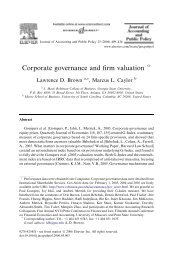Income Dynamics, Economic Rents and the Financialization of the ...
Income Dynamics, Economic Rents and the Financialization of the ...
Income Dynamics, Economic Rents and the Financialization of the ...
You also want an ePaper? Increase the reach of your titles
YUMPU automatically turns print PDFs into web optimized ePapers that Google loves.
tory role <strong>and</strong> became a cheerleader for new financial instruments allowing new organizational<br />
arrangements in <strong>the</strong> finance industry to flourish without regulatory oversight (Fligstein <strong>and</strong><br />
Goldstein 2010). Even formally illegal cross-industry activity, such as investment, insurance, <strong>and</strong><br />
banking all located in single firm became acceptable, even if still illegal. Eventually, <strong>and</strong> in re-<br />
sponse to an earlier merger <strong>of</strong> Citicorp <strong>and</strong> <strong>the</strong> Traveler’s Insurance Company, in <strong>the</strong> Financial<br />
Services Modernization Act <strong>of</strong> 1999 <strong>the</strong> US Congress repealed <strong>the</strong> last regulation on finance<br />
sector behavior from <strong>the</strong> Glass-Steagall Act, now making it legal for investment banks, commer-<br />
cial banks <strong>and</strong> insurance companies to combine operations. This lead to <strong>the</strong> expansion <strong>of</strong> consol-<br />
idated bank holding companies, which operated simultaneously in all financial markets, created<br />
<strong>the</strong> consolidated financial services industry in which family <strong>and</strong> commercial banking, insurance,<br />
<strong>and</strong> investment services could all be provided by a single firm, <strong>and</strong> eventually generated <strong>the</strong> sys-<br />
temic (i.e. concentrated densely networked) risk associated with <strong>the</strong> financial collapse <strong>of</strong> <strong>the</strong> later<br />
2000s. Although <strong>the</strong> key shifts in <strong>the</strong> regulatory field that led to financialization happened in <strong>the</strong><br />
early 1980s, <strong>the</strong> 1999 Financial Services Modernization Act increased <strong>the</strong> concentration <strong>of</strong> <strong>the</strong><br />
finance industry <strong>and</strong> <strong>the</strong> centrality <strong>of</strong> <strong>the</strong> largest financial institutions to <strong>the</strong> economy. Davis<br />
(2009) documents numerous instances in which <strong>the</strong>se diversified large general financial service<br />
firms were beset by conflicts <strong>of</strong> interest <strong>and</strong> sc<strong>and</strong>als after 2000.<br />
Finally, <strong>the</strong> Federal Reserve after decades long experimentation with methods to obscure<br />
<strong>the</strong>ir political role in limiting wage <strong>and</strong> employment growth as it prioritized inflation fighting<br />
over employment or wage growth, finally endorsed a policy <strong>of</strong> letting markets lead policy <strong>and</strong> by<br />
<strong>the</strong> end <strong>of</strong> <strong>the</strong> Twentieth Century embraced <strong>the</strong> efficient markets hypo<strong>the</strong>ses which described<br />
financial markets as self regulating. The latter ultimately lead to support from Federal Reserve<br />
<strong>of</strong>ficials <strong>of</strong> bank requests to end <strong>the</strong> prohibition <strong>of</strong> multiple financial services within a single firm.<br />
20







